
 |
| Parameter | Value | Ref. / Comments |
|---|---|---|
| τ(Bd) | (1.536 ± 0.014) ps | HFAG - Oscillations/Lifetime (Winter 2004) |
| Δmd | (0.502 ± 0.007) ps–1 | HFAG - Oscillations/Lifetime (Winter 2004) |
| |A^| 2 | 0.160 ± 0.032 ± 0.014 | BABAR, PRL 87 (2001) 241801 |
| 0.192 ± 0.023 ± 0.026 | Belle, PL B538 (2002) 11-20 | |
| 0.176 ± 0.025 | Average used for rescaling |
| Parameter: sin(2β/φ1) (if β/φ1 dominant weak phase) | ||||
|---|---|---|---|---|
| Mode | BABAR | Belle | Average | Ref. / Comments |
| J/ψKS, ψ(2S)KS, χc1KS, ηCKS | 0.76 ± 0.07stat | 0.73 ± 0.06stat | - | BABAR PRL 89 (2002) 201802 Belle-CONF-0353, LP'03 (preliminary) |
| J/ψKL (ηCP=+1) | 0.72 ± 0.16stat | 0.80 ± 0.13stat | ||
| J/ψK*0 (K*0 → KSπ0 | 0.22 ± 0.52stat | 0.10 ± 0.45stat | ||
| All charmonium | 0.741 ± 0.067 ± 0.034 | 0.733 ± 0.057 ± 0.028 |
0.736 ± 0.049 (0.043stat-only) |
CL = 0.93 |
| ΦK0 | 0.47 ± 0.34 +0.08–0.06 | –0.96 ± 0.50 +0.09–0.11 | 0.02 ± 0.29
(0.28stat-only) CL=0.021 |
BABAR hep-ex/0403026 (submitted to PRL) BABAR PRL 91 (2003) 161801 PRL 91, 261602 (2003) BABAR Moriond-EW (2004) (preliminary) |
| η'KS | 0.02 ± 0.34 ± 0.03 | 0.43 ± 0.27 ± 0.05 | 0.27 ± 0.21
(0.21stat-only) CL=0.35 |
|
| f0KS | 1.62 +0.51–0.56 ± 0.10 | not yet available | 1.62 +0.51–0.56 ± 0.10 | |
| π0KS | 0.48 +0.38–0.47 ± 0.11 | not yet available | 0.48 +0.38–0.47 ± 0.11 | |
| K+K–KS | 0.56 ± 0.25 ± 0.04 +0.17–0.00 | 0.51 ± 0.26 ± 0.05 +0.18–0.00 | 0.54 ± 0.18 +0.17–0.00
(0.18stat-only) CL=0.89 |
|
| All b → s penguin | 0.42 ± 0.12 (0.12stat-only) | CL = 0.03 | ||
| All modes | 0.690 ± 0.045 (0.41stat-only) | CL = 0.0088 | ||
| Parameter: sin(2β/φ1) | ||||
|---|---|---|---|---|
| Experiment | Value | Ref. / Comments | ||
| ALEPH | 0.84 +0.82–1.04 ± 0.16 | PL B492 (2000) 259-274 | ||
| OPAL | 3.2 +1.8–2.0 ± 0.5 | EPJ C5 (1998) 379-388 | ||
| CDF (full Run I) | 0.79 +0.41–0.44(stat+syst) | PRD 61 (2000) 072005 | ||
| Parameter: sin(2β/φ1) | ||||
|---|---|---|---|---|
| All charmonium | 0.739 ± 0.048 | |||
| All modes | 0.692 ± 0.045 | |||
| Parameter: C=–A (if not stated otherwise) | ||||
|---|---|---|---|---|
| Mode | BABAR | Belle | Average | Ref. / Comments |
| Charmonium | |λ| = 0.948 ± 0.051 ± 0.030 |
0.950 ± 0.049 ± 0.034 (added DCSD systematics) |
0.949 ± 0.045 (0.035stat-only) CL = 0.98 |
BABAR PRL 89 (2002) 201802 Belle PRD 66 (2002) 071102 |
| C = 0.053 +0.055–0.052 +0.032–0.031 |
0.051 +0.053–0.050
+0.035–0.036 (added DCSD systematics) |
0.052 +0.048–0.046
(0.037stat-only)
CL = 0.98 |
||
| ΦKS | 0.01 ± 0.33 ± 0.10 | 0.15 ± 0.29 ± 0.08 (added DCSD systematics) |
0.09 ± 0.23 CL=0.76 |
BABAR hep-ex/0403026 (submitted to PRL) BABAR PRL 91 (2003) 161801 PRL 91, 261602 (2003) BABAR Moriond-EW (2004) (preliminary) |
| η'KS | 0.10 ± 0.22 ± 0.04 (added DCSD systematics) |
0.01 ± 0.16 ± 0.05 (added DCSD systematics) |
0.04 ± 0.13 CL=0.75 |
|
| f0KS | 0.27 ± 0.36 ± 0.12 | not yet available | 0.27 ± 0.36 ± 0.12 | |
| π0KS | 0.40 +0.27–0.28 ± 0.10 | not yet available | 0.40 +0.27–0.28 ± 0.10 | |
| K+K–KS | –0.10 ± 0.19 ± 0.09 | 0.17 ± 0.16 ± 0.05 (added DCSD systematics) |
0.07 ± 0.13 CL=0.31 |
|
| All b → s penguin | 0.09 ± 0.08 (0.08stat-only) | CL = 0.92 | ||
| All modes | 0.059 ± 0.039 (0.033stat-only) | CL = 0.97 | ||
|
Constraining CJ/ψ Ks
from ACP(B+ → J/ψ K+)
and ASL: as suggested by
Y. Nir,
one can obtain a powerful SM constraint on
|λ| = |q/p||A-bar/A| via the relations
ASL = (1–|q/p|4)/(1+|q/p|4)
and
ACP(B+ → J/ψ K+)
= (|A-bar/A|2–1)/(|A-bar/A|2+1),
where ASL denotes the CP asymmetry in semileptonic
B decays,
and ACP(B+ → J/ψ K+)
is the CP-violating charge asymmetry measured in
B+ → J/ψ K+ decays.
Averaging the ASL results from
BABAR,
CLEO,
ALEPH and
OPAL,
as well as the ACP(B+ → J/ψ K+)
results from
BABAR,
Belle and
CLEO,
we find
ASL = 0.001 ± 0.014 and
ACP(B+ → J/ψ K+)
= –0.007 ± 019. This
gives
|q/p| = 0.9996 +0.0068 –0.0067,
|A-bar/A| = 0.993 ± 0.018,
and hence
|λ|indirect = 0.992 ± 0.019
(see right hand plot below).
Discussion: the amplitude relation between neutral and charged B → J/ψ K decays has been found by Fleischer-Mannel to hold up to negligible corrections of the order O(λ3). However, it was pointed out by D. Kirkby that the identification of |λ|, measured through the C coefficient in B0 → J/ψ K0, with |q/p||A-bar/A| assumes ΔΓBd=0. The ratio ΔΓBd/ΔmBd it is expected to be small in the SM. |
| Compilation of results for –ηS ≈ sin(2β/φ1) and C (the two right hand plots show averages) |
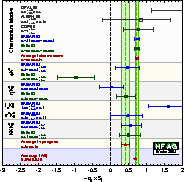 eps gif gif(high res) |
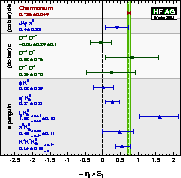 eps gif gif(high res) |
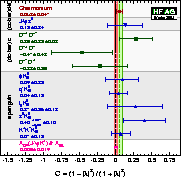 eps gif gif(high res) |
|
Constraining the Unitarity Triangle (ρ, η):
the measurement of sin(2β) from charmonium modes
can be compared in the ρ-bar-η-bar plane (ρ-bar, η-bar being the
parameters in the exact (unitary)
Wolfenstein
parameterization of the CKM matrix) with the constraints from
other experimental inputs. Visit the CKMfitter homepage and the UTfit homepage for results on global CKM fits using different fit techniques and input quantities. |
| Experiment | SJ/ψπ0 | CJ/ψπ0 = –AJ/ψπ0 | Correlation | Ref. / Comments | |
|---|---|---|---|---|---|
|
BABAR'02 N(BB)=88m |
0.05 ± 0.49 ± 0.16 | 0.38 ± 0.41 ± 0.09 | –0.12 | PRL 91 (2003) 061802 | |
| Belle'03 N(BB)=151m |
–0.72 ± 0.42 ± 0.08 | 0.01 ± 0.29 ± 0.07 | –0.12 | Belle CONF-0342 (LP'03) | |
| Average (preliminary) |
–0.40 ± 0.33 | 0.13 ± 0.24 | –0.12 | χ2 = 2.1 (CL = 0.36 → 0.9σ) | |
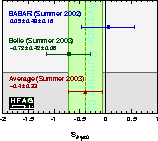 eps gif gif (high res) |
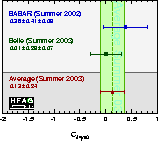 eps gif gif (high res) |
nothing | |||
| Experiment | SD*+D*– | CD*+D*– | Correlation | Ref. / Comments | |
|---|---|---|---|---|---|
| BABAR'03 N(BB)=88m |
Im(λ) = 0.05 ± 0.29 ± 0.10 | |λ| = 0.75 ± 0.19 ± 0.02 | 0.18 |
PRL 91 (2003) 131801 f(CP-odd) = 0.063 ± 0.055 ± 0.009 |
|
| S = 0.06 ± 0.37 ± 0.13 | C = 0.28 ± 0.23 ± 0.02 | –0.15 | |||
| Belle | not yet available | ||||
| Experiment | S+–(D*+D–) | C+–(D*+D–) | S–+(D*–D+) | C–+(D*–D+) | A+– | Ref. / Comments |
|---|---|---|---|---|---|---|
|
BABAR'03 N(BB)=89m |
–0.82 ± 0.75 ± 0.14 | –0.47 ± 0.40 ± 0.12 | –0.24 ± 0.69 ± 0.12 | –0.22 ± 0.37 ± 0.10 | –0.03 ± 0.11 ± 0.05 | PRL 90 (2003) 221801 |
| Belle | not yet available | |||||
| Compilation of results for sin(2βeff/φ1,eff)=–S (left figure) and C (right figure) from time-dependent b → cc-bar d analyses. The results are compared to the values from the corresponding charmonium averages. |
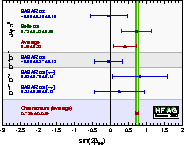 eps gif gif(high res) |
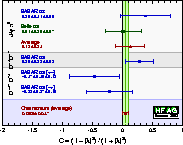 eps gif gif(high res) |
| Experiment | Sππ | Cππ = –Aππ | Correlation | Ref. / Comments | |
|---|---|---|---|---|---|
| BABAR'03 N(BB)=123m |
–0.40 ± 0.22 ± 0.03 | –0.19 ± 0.19 ± 0.05 | –0.02 | BABAR-Plot-0053 (preliminary) | |
|
updated Winter'04: Belle'04 N(BB)=152m |
–1.00 ± 0.21 ± 0.07 | –0.58 ± 0.15 ± 0.07 | –0.286 | hep-ex/0401029 | |
| Average | –0.74 ± 0.16 | –0.46 ± 0.13 | –0.17 | χ2 = 6.9 (CL = 0.031 → 2.2σ) | |
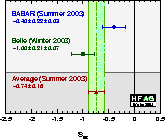 eps gif gif (high res) |
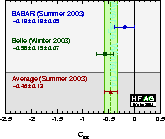 eps gif gif (high res) |
nothing | |||
The Penguin-to-tree ratio:
using as input the measured
Cππ and Sππ coefficients
together with the Wolfenstein parameters ρ and η from
the Global CKM fit
using standard constraints,
one can infer module and phase of the complex penguin
to tree (P/T) ratio
in Bd→ π+π–
decays within the Standard Model. Note that the definition of P/T is
convention-dependent (see, e.g.,
GroRo02).
We choose to eliminate the charm quark in
the penguin loop using CKM unitarity, so that the amplitudes can be
parameterized as follows:
| ||||||||
| Experiment | ACP(ρπ) | Sρπ | Cρπ | ΔSρπ | ΔCρπ | Correlations | Ref. / Comments |
|---|---|---|---|---|---|---|---|
| BABAR'03 N(BB)=123m |
–0.114 ± 0.062 ± 0.027 | –0.13 ± 0.18 ± 0.04 | 0.35 ± 0.13 ± 0.05 | 0.33 ± 0.18 ± 0.03 | 0.20 ± 0.13 ± 0.05 | Table | LP'03 update: BABAR-Plot-0055 (preliminary) |
| Belle | not yet available | ||||||
|
Direct CP violation: as shown by
Charles
it is convenient to transform the experimentally motivated direct
CP parameters ACP(ρπ) and Cρπ
into the physically motivated A+–(ρπ) = (|κ+–|2–1)/(|κ+–|2+1) = –(ACP(ρπ)+Cρπ+ACP(ρπ)ΔCρπ)/(1+ΔCρπ + ACP(ρπ)Cρπ), A–+(ρπ) = (|κ–+|2–1)/(|κ–+|2+1) = (–ACP(ρπ)+Cρπ+ACP(ρπ)ΔCρπ)/(–1+ΔCρπ + ACP(ρπ)Cρπ), where κ+–=(q/p)Abar–+/A+– and κ–+=(q/p)Abar+–/A–+. With this definition A–+(ρπ) (A+–(ρπ)) describes direct CP violation in Bd decays where the ρ is emitted (not emitted) by the spectator interaction. Taking into account experimental correlations, one finds A+–(ρπ) = –0.18 ± 0.13 ± 0.05, A–+(ρπ) = –0.52 +0.17–0.19 ± 0.07, where the first errors are statistical and the second systematic. The two quantities are experimentally correlated to +51%. The probability to observe these numbers in the absence of direct CP violation is 1.5%. See right hand plot for a confidence level representation in the A+–(ρπ) versus A–+(ρπ) plane. |
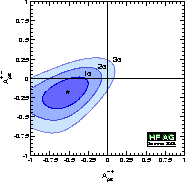 eps gif gif (high res) |
||||||||||||||||||||
Flavor-charge specific branching fractions: the charge and
flavor asymmetry parameters ACP(ρπ), Cρπ and
ΔCρπ can be used to derive flavor-charge specific
rates from the
HFAG branching fraction
BR(Bd→ ρ+–π–+)=(24.0 ± 2.5) 10–6.
|
|||||||||||||||||||||
| Experiment | Slong | Clong | Correlation | Ref. / Comments |
|---|---|---|---|---|
| BABAR'04 N(BB)=123m |
–0.19 ± 0.33 ± 0.11 | –0.23 ± 0.24 ± 0.14 | 0.04 | BABAR Moriond-EW (2004) (preliminary) |
| Belle | not yet available | |||
| The Penguin-to-tree ratio: using as input the measured Clong and Slong coefficients together with the Wolfenstein parameters ρ and η using standard constraints, one can infer module and phase of the complex penguin to tree (P/T) ratio as done in the ππ case. Plots for confidence level representations of the P/T phase versus its module can be found on the corresponding CKMfitter and UTfit pages. |
| Constraining α: using as input the measured Clong and Slong coefficients together with the present (HFAG) ρρ branching fractions and longitudinal polarization fractions (including the limit on ρ0ρ0, for which the polarization is unknown), one can perform the Gronau-London isospin analysis (electroweak penguins can be taken into account, while other SU(2)-breaking effects are usually neglected). Plots for confidence level representations of the P/T phase versus its module can be found on the corresponding CKMfitter and UTfit pages. |
| Observable | BABAR | Belle | Average* | Ref. / Comments | |
|---|---|---|---|---|---|
| partially reconstructed |
fully reconstructed |
fully reconstructed |
|||
| a* | –0.063 ± 0.024 ± 0.014 | –0.068 ± 0.038 ± 0.020 | 0.060 ± 0.040 ± 0.017 |
–0.037 ± 0.021 CL=0.04 |
BABAR hep-ex/0310037 (partial. rec., preliminary) (submitted to PRL) BABAR hep-ex/0309017 (fully rec., preliminary) (submitted to PRL) Belle hep-ex/0308048 (submitted to PRL) |
| c* | –0.004 ± 0.037 ± 0.020
(lepton tags only) |
0.031 ± 0.070 ± 0.033
(lepton tags only) |
0.049 ± 0.040 ± 0.019 |
0.022 ± 0.028 CL=0.68 |
|
| a | - | –0.022 ± 0.038 ± 0.020 | –0.062 ± 0.037 ± 0.016 |
–0.043 ± 0.029 CL=0.50 |
|
| c | - | 0.025 ± 0.068 ± 0.033
(lepton tags only) |
–0.025 ± 0.037 ± 0.018 |
–0.014 ± 0.036 CL=0.56 |
|
| Experiment | γ/φ3 | Ref. / Comments | |||||
|---|---|---|---|---|---|---|---|
| Belle'04 N(BB)=152m |
81° ± 19°(1σ*) ± 13° ± 11°model |
Belle Lake Luise (2004) and Belle Moriond (2004) (preliminary) |
|||||
| BABAR | not yet available | ||||||